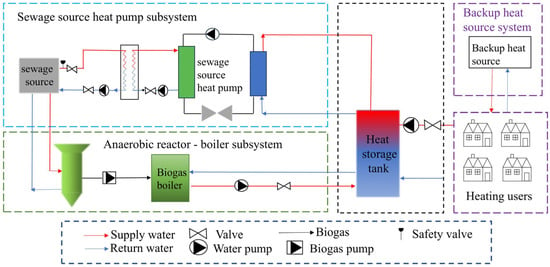In areas rich in solar energy resources, Chen Yaowen et al. proposed a centralized solar energy and biogas mixed heating system to meet the needs of rural areas and improve the stability and economy of the system heating. The economic feasibility of the combined heating system is better than that of the traditional single solar heating system, and the investment payback period can be shortened by about 50% [7]. Long research teams proposed a composite heating system combining solar hot water and an air source heat pump to achieve a variety of heating methods of combined heating, including parallel, series, and other connection methods. In the cold season, through simulation analysis, it was found that solar radiation and ambient temperature have important effects on energy efficiency, especially in cold climates. The combined application of solar energy and air source heat pumps is expected to improve the performance of heating systems [8]. Yang Weibo et al. conducted an in-depth study on the different coupling modes of solar ground source heat pump systems installed in buildings in Nanjing. The results show that the heating load ratios of solar energy and geothermal energy are 43.3% and 50.2%, respectively, when the system is operated day and night. During the day, solar collectors collect excess heat and store it in the soil for end-use heating at night. This operation mode effectively improves the efficiency of the collector and realizes the efficient coupling of solar energy and geothermal energy [9]. Huan, C proposed a combined solar-assisted heat pump system with two modes of operation, series and parallel. The research team performed performance tests on the system using TRNSYS 18_1 software. The results show that the system has excellent performance in energy saving [10]. In an area rich in geothermal resources, Wang Yubo et al. studied the feasibility of the air-ground source heat pump coupled energy storage system and calculated that, compared with the traditional ground source heat pump system, the annual operating cost of the new system is only 58% of that of the traditional system, and the carbon emission can be reduced by 7.14%, which has good economic and environmental benefits [11]. Zhang Congguang et al. conducted an experimental study on the thermal performance of the combined solar energy and ground source heat pump system of a single-family residence, focusing on the dynamic thermal behavior of the heat accumulator under different working conditions, and the results verified the operational reliability and good economic and environmental benefits of the combined system [12]. In the oilfield area, there is a large amount of waste heat resources to be used, which attracts domestic and foreign scholars to study it [13]. Zhu et al. proposed an innovative heating system that uses oil production water as a heat source. The system is unique in that it not only meets the heating needs of the building, but also effectively reduces the consumption of fossil fuels and reduces carbon dioxide emissions. By utilizing these wastewater waste heat resources, energy costs are reduced and dependence on traditional energy sources is reduced. In addition, such heating systems help to reduce adverse environmental impacts and promote sustainable development. Therefore, the utilization of waste heat from oilfield wastewater has great potential in the field of heating, which is worthy of further study and application [14].
Chatz istougianni, N et al. proved through experimental studies that biomass can be used as a heat source to support small-scale central heating systems, especially for public buildings. This study provides practical demonstration and support for the application of biomass energy in heating system [15]. Our research team, including Tian Yishui and other scholars, conducted research on solar energy and biomass energy combined heating system, proposed a design scheme, and established an economic analysis model. The results show that this system can make full use of the advantages of biomass energy and solar energy, extend the service life of biomass pellet burners, and make up for the shortcomings of solar energy instability. It is highly complementary. This research provides a new idea and scheme for the joint application of renewable energy [16].
Source link
Meng Xu www.mdpi.com

